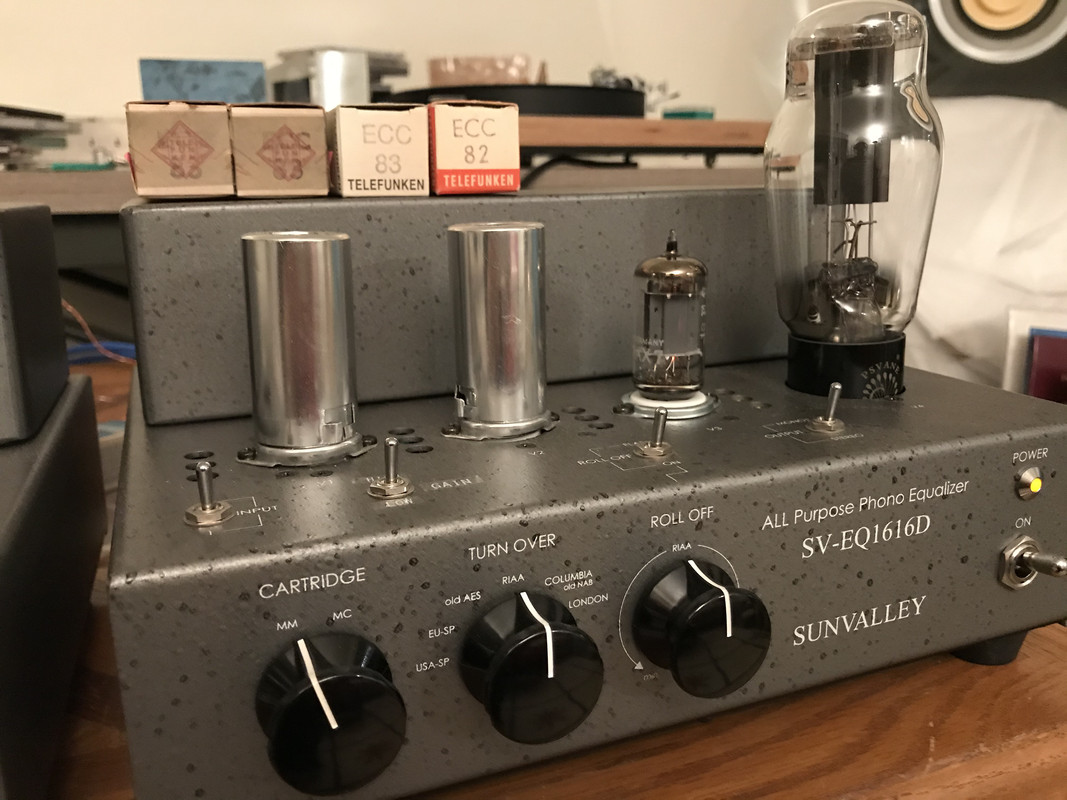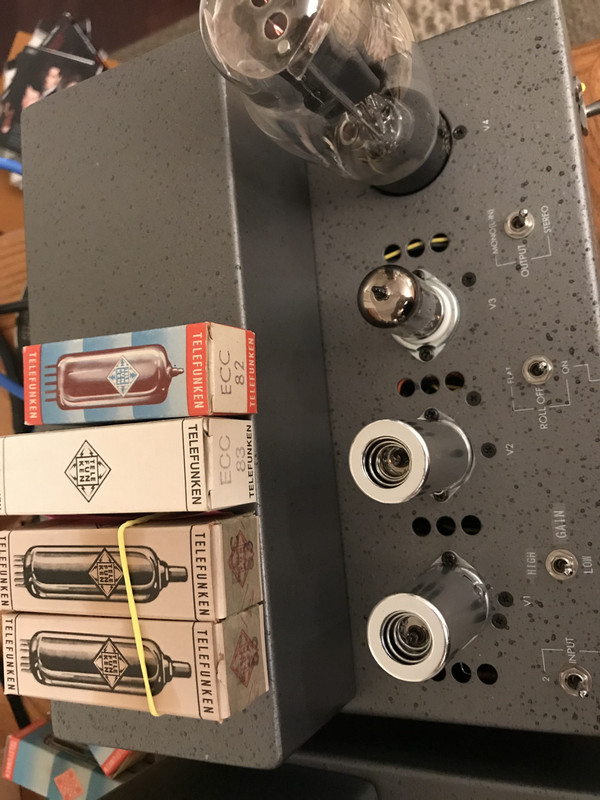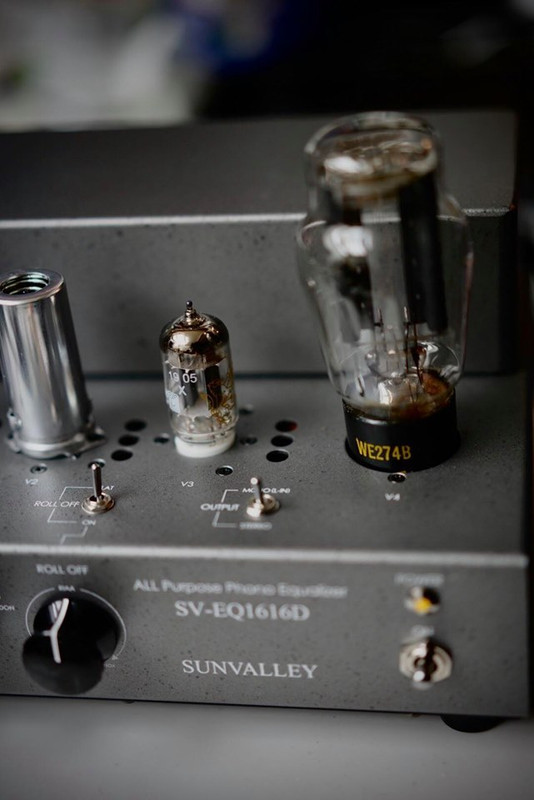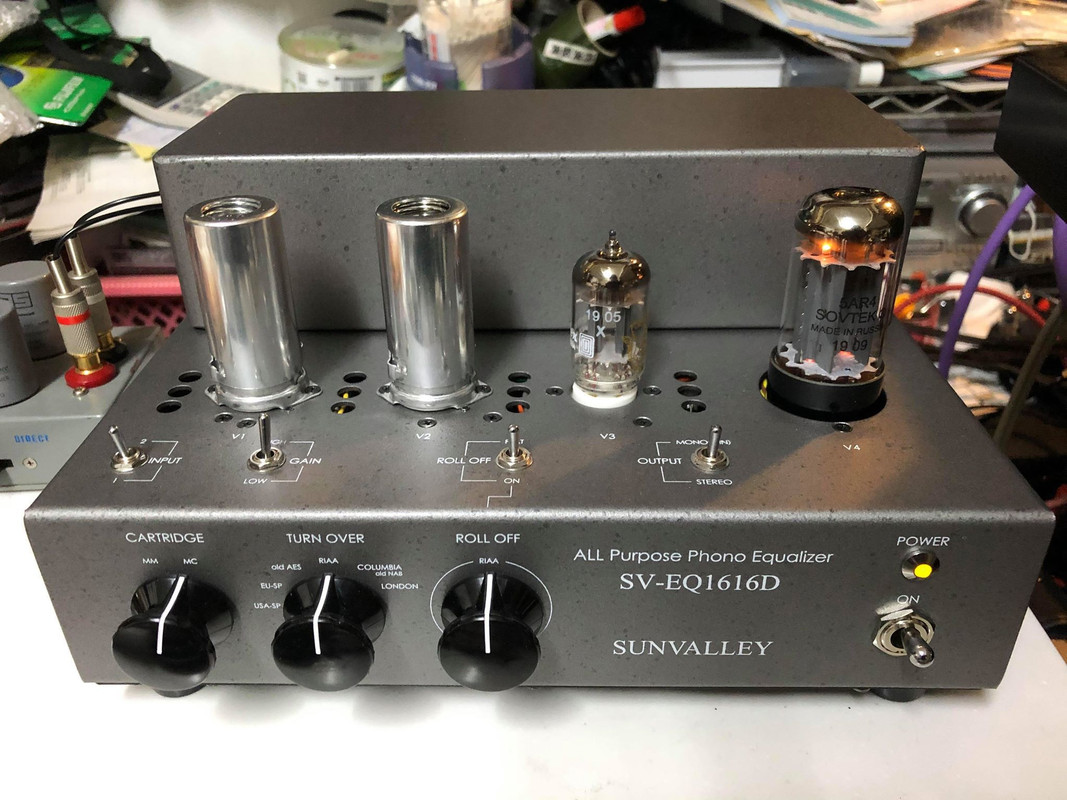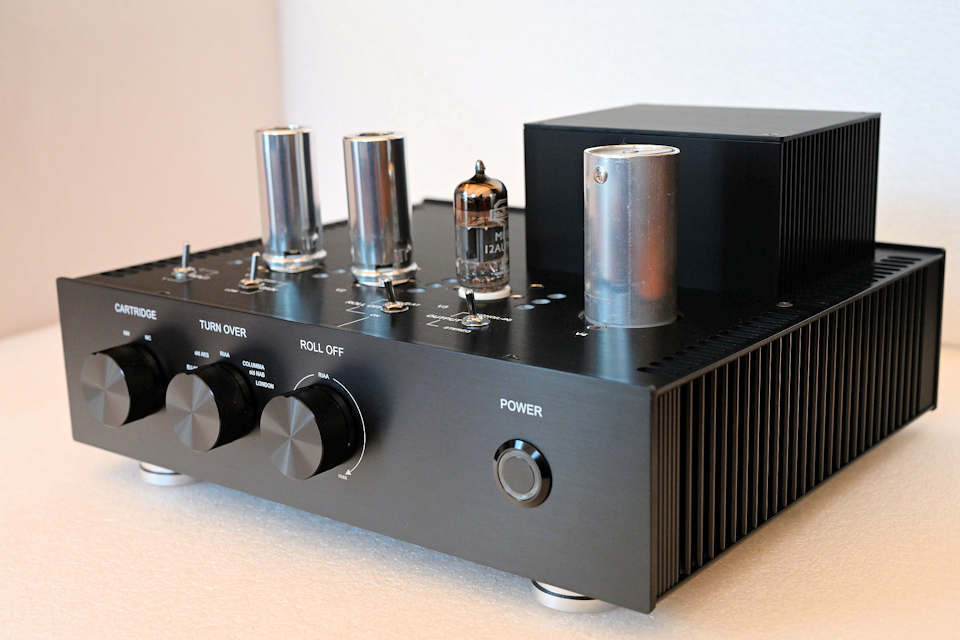Twitchie--Wiring looks nice. One tip I found the hard way--some of the small lug terminals have up to six connections, 2 wires and 4 resistors. If you solder any of the first connections, it's almost impossible to get all 6 in. The second time I did the wiring, I checked ahead in the directions to see how many things were going in each terminal. If it was 4 or more, I didn't solder any of them until they were all squeezed in.
I really like Mr. Y's chassis. I prefer black since all of my equipment is black, except for my SV-EQ1616D.
However, if I were going to go to all that trouble, I would have made the chassis larger to accommodate the Lundahl MC upgrade and to make it easier to wire the components. Maybe he did make it larger, but the pictures don't seem to indicate that. I would love to see photos of his wiring inside.
Another thing I would change is the tube sockets. It seems you could use a different socket that would hold the tube better so that you didn't need to use the metal cans to keep them in place. I like the bare tube look. Maybe I don't know what I'm talking about and the cans serve a different purpose.
However, if I were going to go to all that trouble, I would have made the chassis larger to accommodate the Lundahl MC upgrade and to make it easier to wire the components. Maybe he did make it larger, but the pictures don't seem to indicate that. I would love to see photos of his wiring inside.
Another thing I would change is the tube sockets. It seems you could use a different socket that would hold the tube better so that you didn't need to use the metal cans to keep them in place. I like the bare tube look. Maybe I don't know what I'm talking about and the cans serve a different purpose.
Rock Ball - you misunderstand the reason for the metal shields. They are RF/noise shields rather than to hold the tubes in place (though they do help and act as tube dampers for low frequency mechanical/thermal noise). The tubes will stay firmly in place without the shields and there is a good chance you will not hear any difference with or without. There will still be a small metal connector around the bottom if you leave the shield off. On the upside, you can simply purchase a couple of high quality tube sockets to replace the stock ones for under $20 when you build.
There should be plenty of room for the Lundahl SUT in either chassis as it likely drops into place where the FET MC gain board was mounted. They are quite small. A pic of the installation would be helpful.
There should be plenty of room for the Lundahl SUT in either chassis as it likely drops into place where the FET MC gain board was mounted. They are quite small. A pic of the installation would be helpful.
Last edited:
That does not surprise me!Rock Ball - you misunderstand the reason for the metal shields.
The tubes will stay firmly in place without the shields . . .
Actually, mine don't. It may have to do with the way I soldered the components to the tube socket terminals. I allowed for a little spring in the component wire so that the pin sockets weren't rigid. The tubes seem too easy to remove compared to other tube equipment that I own. I have to use the metal shields to keep mine in place.
Thanks for the information about the metal shields. I wonder why all tubes don't have them?
Those are high gain tubes for the small signal coming from a cartridge and are more susceptible to picking up noise from the outside compared to similar tubes run with a higher input signal (for instance, from a CD player or tuner, etc.). Many tubes in a tube-tuner are shielded for a similar reason as they handle the small FM broadcast signal. Shielding can also be useful when the piece of gear itself creates noise.
Review is available now
Stereophile November 2020 Edition
EXTRACTED : Stereophile November 2020 edition
The SV-EQ1616D was giving me expensive, moving-coil–type pleasures, but I was not using a fancy moving- coil cartridge.
With the SV-EQ1616D, each of these combinations generated the most vivid and nuanced analog sound I’ve had in this apartment.
Even if you can’t afford, or don’t want, a $52,000 phono preamplifier, you can still experience massive doses of the extramundane by setting a needle on some black discs. The inexpensive Sunvalley SV-EQ1616D could be part of that experience. But I warn you, if you start using the Sunvalley, it could lead to harder drugs.
Stereophile November 2020 Edition
EXTRACTED : Stereophile November 2020 edition
The SV-EQ1616D was giving me expensive, moving-coil–type pleasures, but I was not using a fancy moving- coil cartridge.
With the SV-EQ1616D, each of these combinations generated the most vivid and nuanced analog sound I’ve had in this apartment.
Even if you can’t afford, or don’t want, a $52,000 phono preamplifier, you can still experience massive doses of the extramundane by setting a needle on some black discs. The inexpensive Sunvalley SV-EQ1616D could be part of that experience. But I warn you, if you start using the Sunvalley, it could lead to harder drugs.
SV-EQ1616D
Hi'
I loved the construction story and the great pictures.
I do not agree with the use of unbypassed diodes , 1N4007 or UF4007 diodes in the solid state rectifier picture. There should be at least a .01mfd 1000 volt mylar cap and a 470k resistor across each diode.This is to eliminate diode switching noise and to the protect the diodes , according to the ARRL Radio Amateurs Handbook.
The review by Herb Reichert in the 11/20 Stereophile mag was great. I do not however agree with Herb's opinion of the RCA phono preamp from the RCA tube manual , there are problems with the equalization curve and the high output impedance. I do agree with Herb that the power supply to this or any amplifier type benefits from a stable well filtered power supply , you can hear the difference.
Can I get a schematic please ?
Thank You
Ed Lipman
Hi'
I loved the construction story and the great pictures.
I do not agree with the use of unbypassed diodes , 1N4007 or UF4007 diodes in the solid state rectifier picture. There should be at least a .01mfd 1000 volt mylar cap and a 470k resistor across each diode.This is to eliminate diode switching noise and to the protect the diodes , according to the ARRL Radio Amateurs Handbook.
The review by Herb Reichert in the 11/20 Stereophile mag was great. I do not however agree with Herb's opinion of the RCA phono preamp from the RCA tube manual , there are problems with the equalization curve and the high output impedance. I do agree with Herb that the power supply to this or any amplifier type benefits from a stable well filtered power supply , you can hear the difference.
Can I get a schematic please ?
Thank You
Ed Lipman
It requires a lot of skill to assemble a point to point amp
I only trust the the technicians from Sunvalley. The layout is perfect.
 beta fish centerpiece ideas
beta fish centerpiece ideas
I only trust the the technicians from Sunvalley. The layout is perfect.
 beta fish centerpiece ideas
beta fish centerpiece ideasRegarding MC cartridges and impedance matching. I understand that the MC loading of this amp is a fixed 50 ohm. Where an MC cartridge manufacturer states that the loading should be, say, >400 ohm - can the loading of the MC input of the phonoamp be adjusted to comply with the manufacturer's recommendation?
Easy solution is one of K&K's SUTs in place of the FETs. With the K&K SUT you can easily change the resistors to best match your cartridge loading. Another advantage with a SUT is the fact it is then a true tube phono stage rather than having solid-state devices in the signal path.
Sorry a follow up q - with the K&K SUTs - would it be recommended to get this from K&K as a standalone offboard kit and plug into the MM input of the Sunvalley, or alternatively install it within the Sunvalley chassis itself? If anyone has done the later i'd be grateful to see a photo
- Status
- This old topic is closed. If you want to reopen this topic, contact a moderator using the "Report Post" button.
